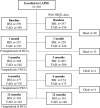Association of Illness Severity With Family Outcomes Following Pediatric Septic Shock
- PMID: 35733611
- PMCID: PMC9203075
- DOI: 10.1097/CCE.0000000000000716
Association of Illness Severity With Family Outcomes Following Pediatric Septic Shock
Abstract
It is unknown which families are at risk for poor outcomes following a child's critical illness.
Objectives: To evaluate if pediatric septic shock severity is associated with caregiver distress and family dysfunction throughout the year postadmission and if caregiver outcomes are associated with child health-related quality of life (HRQL).
Design setting and participants: Secondary analysis of the Life After Pediatric Sepsis Evaluation prospective cohort study among children less than 18 years old with community-acquired septic shock requiring vasoactive-inotropic support and invasive or noninvasive ventilation in 12 academic U.S. PICUs.
Main outcomes and measures: Caregivers reported personal psychologic distress (Brief Symptom Inventory), family functioning (Family Assessment Device), and child HRQL (Pediatric Quality of Life Inventory, Functional Status II-Revised) at baseline and 1, 3, 6, and 12 months following PICU admission.
Results: Among 276 caregivers, psychologic distress prevalence initially decreased then rose to 15.3%, whereas prevalence of family dysfunction increased steadily to 30.9% at 12 months. On multivariable logistic regression adjusting for patient age, medical complexity, and immunosuppression, higher Pediatric Risk of Mortality and vasoactive-inotropic scores and longer PICU and hospital stay were associated with greater caregiver distress at 1 month. Higher Pediatric Logistic Organ Dysfunction (PELOD) score, longer ventilation, and longer PICU stay were associated with lower odds of family dysfunction at 1, 3, and 6 months (average PELOD vs new 6-mo dysfunction: odds ratio [OR], 0.73 [95% CI, 0.55-0.96]). Caregiver distress was associated with child HRQL decline from baseline to 1 month (OR, 2.92 [1.27-6.75]), 3 months (OR, 2.34 [1.01-5.42]), and 12 months (OR, 3.94 [1.54-10.06]).
Conclusions and relevance: Family dysfunction becomes increasingly prevalent over the year following pediatric septic shock and is less likely following higher severity illness. Caregiver psychologic distress is associated with worse child HRQL. Both patients and families may benefit from ongoing psychosocial support following survival from pediatric septic shock.
Keywords: caregivers; health-related quality of life; intensive care units; pediatric; psychologic distress; septic; shock.
Copyright © 2022 The Authors. Published by Wolters Kluwer Health, Inc. on behalf of the Society of Critical Care Medicine.
Conflict of interest statement
The authors have disclosed that they do not have any potential conflicts of interest.
Figures


References
-
- Czaja AS, Zimmerman JJ, Nathens AB: Readmission and late mortality after pediatric severe sepsis. Pediatrics 2009; 123:849–857 - PubMed
-
- Buysse CM, Raat H, Hazelzet JA, et al. : Surviving meningococcal septic shock: Health consequences and quality of life in children and their parents up to 2 years after pediatric intensive care unit discharge. Crit Care Med 2008; 36:596–602 - PubMed
-
- Bronner MB, Knoester H, Sol JJ, et al. : An explorative study on quality of life and psychological and cognitive function in pediatric survivors of septic shock. Pediatr Crit Care Med 2009; 10:636–642 - PubMed
Grants and funding
- U10 HD050012/HD/NICHD NIH HHS/United States
- UG1 HD049983/HD/NICHD NIH HHS/United States
- UG1 HD050096/HD/NICHD NIH HHS/United States
- U10 HD063106/HD/NICHD NIH HHS/United States
- UG1 HD063108/HD/NICHD NIH HHS/United States
- R01 HD073362/HD/NICHD NIH HHS/United States
- U01 HD049934/HD/NICHD NIH HHS/United States
- UG1 HD049981/HD/NICHD NIH HHS/United States
- UG1 HD083170/HD/NICHD NIH HHS/United States
- UG1 HD083166/HD/NICHD NIH HHS/United States
- UG1 HD083171/HD/NICHD NIH HHS/United States
- K23 HD100566/HD/NICHD NIH HHS/United States
LinkOut - more resources
Full Text Sources

